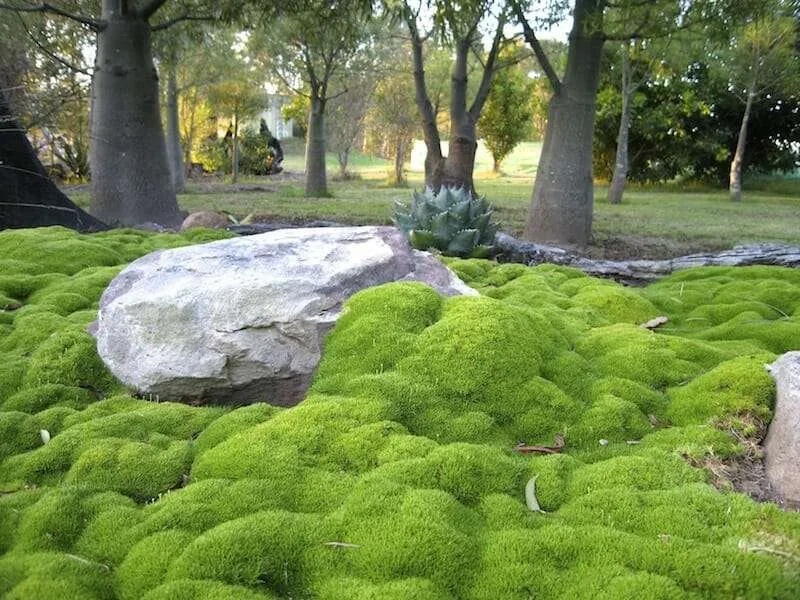Geum (aka Avens), Geum spp.
Once gardeners get to know geums (also known as avens), a relatively uncommon perennial, they often seek out others. Kirsty Wilson, the author of Planting With Nature and the herbaceous supervisor at The Royal Botanic Garden Edinburgh, first planted Geum ‘Totally Tangerine’ in her award-winning show garden, The Coffee Garden back in 2019. The garden’s palette of lime, orange (including ‘Totally Tangerine’), and brown was inspired by the colors of coffee bean fruits. Today, Wilson has a list of geums she likes to use in her designs.
It’s not just professional plantswomen like Wilson who have discovered the joys of geums. Ohio gardener Brad Johnson, the content creator behind @garden.evolution, says he fell in love with geums accidentally. “I stumbled across the cultivar ‘Mai Tai’ at a local garden center and gathered a couple up just to try them out,” he says. Johnson quickly found himself seeking out more—and with good reason: Geums are easy to grow, loved by pollinators, and long blooming; they even have lovely foliage.
Here’s everything you need to know about growing geums.

Members of the rose family, the rhizomatous perennials’ blooms resemble tiny roses, which look great in the garden and in cut bouquets. “I love the repeat flowering, and the flowers last a long time—geums really do perform,” says Wilson. Kate Gould, a garden designer and founder of Kate Gould Gardens in London, likes geums because she says, “they add punch, depth and impact.” More widespread in the United Kingdom than the U.S., geums are well worth seeking out.

Suitable for zones 3-9, geums are relatively tough plants, according to the experts we spoke with. Gould says, “Give them some sun or light shade and a soil that is well worked, and they will easily reward you.” Johnson finds the flowers last longer with some afternoon shade but they can handle full sun with extra moisture (though they may not be so happy in full sun if you live further south). Johnson also notes that clay soil doesn’t seem to bother them.

With their long, wiry stems, geums make good cut flowers, but not necessarily in their first few years. “It will take a few years to establish and give you nice long stems for cuttings,” says Wilson, who advises picking geums when the blooms are half open for the longest lasting cut flowers. Some varieties like ‘Totally Tangerine,’ naturally have longer stems than more compact varieties.
Once they get going, division is encouraged to keep your geums vigorously flowering. Gould recommends dividing the clumps every three to five years. Johnson adds that he’s been dividing his every couple years because they are considered a short-lived perennial. “Dividing reinvigorates them and keeps them going longer. I’ve had some for as long as five years now,” he adds. (However, note that when the Chicago Botanic Garden trialed geums, they found that many grew vigorously without the chore of division.)

Geums will generally flower from May through July, filling a period in the garden that can often be light of blossoms. If you cut or deadhead, Wilson says “they will reward you with a second flush of blooms in early autumn.” In Zone 6, Johnson says his are usually up by late spring, but one bloomed in March in 2023’s mild weather.
Cheat Sheet

- Geums are members of the rose family.
- Native to Asia, Africa, Europe, and North and South America, they can be found nearly everywhere.
- There are about 50 species of plants in the Geum genus.
- They are considered short-lived perennials.
- Blooms are long-lasting and begin in late spring and may last until late summer.
- Geums grow in a mounding habit, with blooms on wiry stems.
Keep It Alive

- Hardy in USDA Zones 3-9.
- Plant in well-draining, moist, fertile soil. Most geums are not particularly drought- or heat-tolerant.
- Geums do well in full sun to part shade. In hot regions, they like shade in the afternoon.
- Deadhead to encourage repeat blooms.
- Requires division every few years.
See also:














Have a Question or Comment About This Post?
Join the conversation